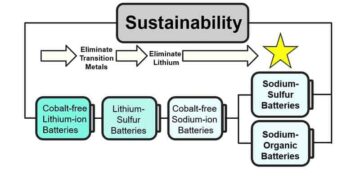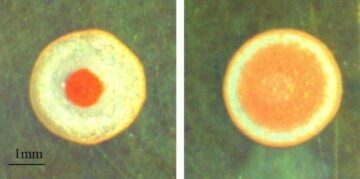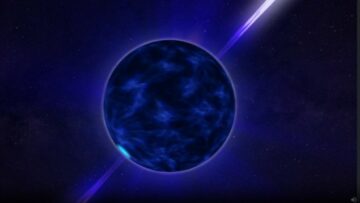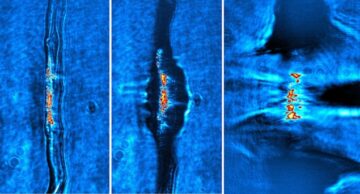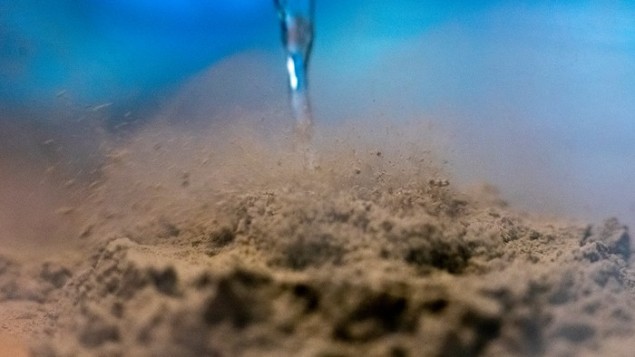
The Moon is a dusty place, and the fine, sharp particles can cause lots of problems if they get into the wrong areas. This is an important consideration for people who are developing equipment and spacesuits for future missions to the Moon. The dust could also cause lung disease in astronauts if it is inhaled.
During the Apollo missions of the 1960s and 1970s, astronomers used brushes to deal with moondust, but it didn’t work very well. Indeed, the fact that the dust is electrostatically charged means that it tends to stick to surfaces.
Now, researchers at Washington State University have developed a new way to remove moondust that involves the Leidenfrost effect. This occurs when drops of liquid are placed on a hot surface, creating a layer of vapour that levitates the drops. When very cold liquid nitrogen is sprayed on a dust-covered surface, the nitrogen vapour that is formed lifts the dust particles and carries them away.
The team tested their dusting technique at atmospheric pressure and in a vacuum chamber to mimic conditions on the Moon. They found that the technique worked even better in vacuum.
The research is described in Acta Astronautica.
Bubbling up
Helium is a finite resource on Earth and there is currently a shortage of the gas. It is created by radioactive decay deep underground. The gas then rises up through rock and gets trapped in some geological structures. Today, almost all helium being used is a by-product of the extraction of oil and gas – and as we reduce our consumption of fossil fuels, this source will diminish. And to make matters worse, Russia is a large producer of helium, and this source is not available to many users.
As well as floating party balloons, liquid plays a crucial role in cooling the superconducting magnets in medical MRI scanners. So, running low on the gaseous element is not a good thing.
Now, a team lead by researchers at the University of Oxford have taken an important step forward in understanding how helium can sometimes get trapped at very high concentrations in underground structures that don’t contain natural gas or the greenhouse-gas carbon dioxide.
Instead, these helium reserves are associated with nitrogen, which is an environmentally benign gas. The team believes that nitrogen bubbles can form in water deep underground. Helium can then get trapped in these bubbles, which rise until they hit impervious rock, trapping the nitrogen and helium. The team also believe that hydrogen could be trapped in the same way. So, such geological structures could also hold reserves of hydrogen – which could be used as a carbon-free source of energy.
The team reports its findings in Nature.
- SEO Powered Content & PR Distribution. Get Amplified Today.
- Platoblockchain. Web3 Metaverse Intelligence. Knowledge Amplified. Access Here.
- Source: https://physicsworld.com/a/liquid-nitrogen-cleans-lunar-dust-new-source-of-helium-may-be-lurking-underground/
- a
- All
- and
- apollo
- areas
- associated
- atmospheric
- available
- being
- believe
- believes
- Better
- carbon
- carbon dioxide
- Cause
- Chamber
- charged
- conditions
- consideration
- consumption
- could
- created
- Creating
- crucial
- Currently
- deal
- deep
- described
- developed
- developing
- Disease
- Dont
- Drops
- Dust
- earth
- energy
- environmentally
- equipment
- Even
- extraction
- fine
- floating
- flow
- form
- formed
- Forward
- fossil fuels
- found
- fuels
- future
- GAS
- get
- good
- helium
- High
- Hit
- hold
- HOT
- How
- HTTPS
- hydrogen
- image
- important
- in
- information
- involves
- issue
- IT
- large
- layer
- lead
- Liquid
- Low
- Lunar
- Magnets
- make
- many
- material
- Matters
- max-width
- means
- medical
- missions
- Moon
- MRI
- Natural
- Natural Gas
- Nature
- New
- Oil
- Oil and Gas
- Oxford
- party
- People
- Place
- plato
- Plato Data Intelligence
- PlatoData
- pressure
- problems
- producer
- reduce
- remove
- Reports
- research
- researchers
- resembles
- reserves
- resource
- Rise
- Rises
- Rock
- Role
- running
- Russia
- same
- sharp
- shortage
- So
- some
- Source
- State
- Step
- Stick
- such
- Surface
- team
- The
- their
- thing
- Through
- thumbnail
- to
- today
- trapping
- true
- understanding
- university
- University of Oxford
- users
- Vacuum
- washington
- washington state
- Water
- which
- WHO
- will
- Work
- worked
- Wrong
- zephyrnet

